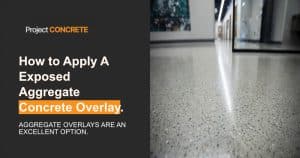
Exposed aggregate concrete overlays are an excellent option for upgrading existing concrete surfaces, offering strength, aesthetic appeal, and resilience at a lower cost than replacing the entire surface. Whether you’re looking to enhance your driveway, walkway, pool area, or patio, this guide provides all the information you need to know about choosing, applying, and maintaining this versatile concrete overlay surface option.
The Benefits of Exposed Aggregate Concrete Overlay
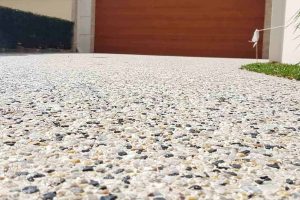
The exposed aggregate concrete overlay can offer a cost effective way to upgrade existing concrete surfaces while providing durability and strength as well. Not only is this an excellent choice for giving the surface aesthetic versatility, but also it provides an economical solution to freshen up your current installations with its durable aggregates that are visibly exposed throughout the overlay of your beloved hardscape creations.
Cost-effective solution
An exposed aggregate concrete overlay is an inexpensive way to improve the outdoor areas. Not only can it save on materials and labor costs, but also provides a cost-effective alternative for replacing full concrete surfaces without having to replace the whole area. The typical expense of such an option ranges from $100 – $150 per square meter making it accessible by most people wanting improved appearances in their spaces. By combining aggregates with existing concrete, this type of overlay creates long lasting protection that shows off beautiful elements usually not visible when left plain.
Enhanced durability and strength
An overlay on a concrete surface can enhance the existing floor and structure’s durability and strength, as well as improve its overall safety. It also offers an attractive element to your space while providing exceptional resilience, making it suitable for areas with heavy traffic flow. Due to this non-slip finish of the overlay applied over the concrete, you will be able to trust that your flooring is reliable all year round!
Aesthetic versatility
An Exposed Aggregate Concrete Overlay is widely sought-after for its aesthetic range, making it the perfect choice to update pool decks and pool surrounds. Its wide selection of colors, textures and aggregate options ensures that any taste or design can be met with ease.
Preparing Your Existing Concrete Surface
For an effective overlay, it is essential that the surface be thoroughly prepared. Through a thorough process of cleaning and removing dirt, as well as addressing any existing cracks or damage to ensure stability in the substrate material – strong adhesion between overlay materials for a high-grade finish can then be achieved.
Cleaning and removing dirt
It is necessary to guarantee that the aggregate overlay adheres properly and removing dirt, dust, or other debris is fundamental. Start with a basic clean-up of the surface, which can be done through vacuuming, sweeping with a broom/dust mop. If more thorough cleaning is required, then an acid solution combined with water should be used. Ensuring these steps are followed will ensure top quality results from your adhesive overlay project.
Repairing cracks and damage
Prior to applying the overlay, all breaks or harm on the concrete surface should be remedied. It is wise to utilize a crack-chaser diamond blade for taking out free concrete and evening out of any cracks. Proper repair methods can help stop more decline and guarantee an effective application of the overlay. The keywords: ‘concrete surface’, ‘concrete’, ‘surface’ & ‘overlay’ must not be forgotten when carrying out these repairs as well as attending to existing splits in order for everything else to work correctly afterwards.
Assessing the stability of the substrate
Before an overlay is applied, it’s important to conduct tests in order to properly assess the substrate’s stability. These may include a Pull-off test, Shear Test, Slant Shear or Splitting, all of which measure bond strength and help determine structural capacity for a more durable application. In short, assessing the underlying surface should be done prior to applying any type of overlay so that its longevity can be guaranteed.
The Exposed Aggregate Overlay Process
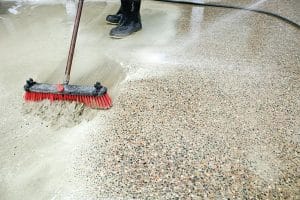
The process of overlay involves combining the required material, putting a top layer in place and revealing aggregate to produce an enduring surface. These three steps guarantee that the result will be robust as well as consistent.
Mixing the overlay material
For the best results, it is suggested to mix overlay material – comprised of natural stones such as basalt, granite, quartz and limestone along with manufactured aggregates like sand, crushed mirror chips or recycled glass – into a wetter consistency before spreading it out evenly using a squeegee.
Applying the overlay
Before applying the overlay, it is essential to clean and prepare the surface. Start by degreasing with a chemical oil remover then spray on some sort of retardant substance followed by misting over lightly with water. Finally lay down your overlay for proper installation, doing so requires precise attention control and skilful execution in order to achieve desired results.
Exposing the aggregates
At the end of the process, a small portion of the mortar on top is chipped away to expose some aggregates for aesthetic purposes – not more than one-third depth with its diameter. This is a video of how aggregate particles are made visible and subsequently achieved in order to complete this step.
Customising Your Exposed Aggregate Surface
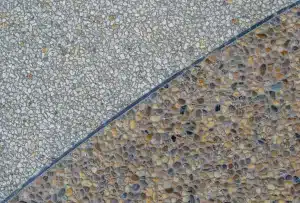
An exposed aggregate surface offers an advantage of being customizable by means of choosing various types and sizes of aggregates, as well as acid and polymer staining. This is achieved to create a unique finish that makes the appearance of this type of surface so appealing.
Acid staining
Acid staining can be used to give the surface an interesting and energetic shade, imitating natural variations such as those found in stone or slate. The acid stain procedure results in a special pattern on the area being treated, which brings out its own uniqueness.
Polymer staining
Polymer staining cement offers more reliable and consistent color application when compared to plain concrete. The pigment penetrates the concrete surface, resulting in a resilient visual effect with lasting uniformity of shade.
Selecting aggregate types and sizes
The surface of a finished product can be drastically altered by the type and size of aggregate used. Smooth, rounded aggregates are known to improve workability while varying sizes and types may create appealing visual effects. Aggregates also lend themselves to providing an effective non-slip surface for increased safety.
Protecting and Maintaining Your Exposed Aggregate Surface
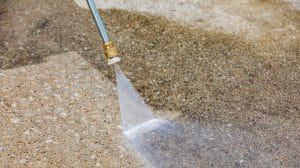
To maintain the look and extended lifetime of your exposed aggregate surface, it is essential to use sealants periodically as well as engage in regular cleaning habits. If needed, utilize resurfacing products right away for any problems that may arise with resurfacing this type of surfaced aggregate area.
Sealing the surface
By sealing the underlying concrete substrate, a protective barrier is formed which shields against weathering and wear as well as preventing stains from seeping into the concrete surface. This layer of protection keeps moisture away for prolonged durability and long-term appeal to any existing or future concrete surfaces installed.
Regular cleaning and maintenance
To maintain the surface in good condition, it is necessary to perform regular cleaning and upkeep. Sweeping needs to be done routinely while a hose should also be employed for occasional rinsing of the pool area so that it does not slip into bad shape.
Addressing potential issues
Periodically inspecting surfaces for stone displacement or hollows can help to save money and prevent problems, as early detection of these issues allows them to be dealt with quickly. Through regular assessments it is possible to find any potential threats before they become more costly repair or replacement jobs.
Conclusion
Exposed aggregate is an efficient and economical way to protect and upgrade existing concrete surfaces. It can add years of additional durability while also providing aesthetically pleasing versatility in customizing the look. These overlays need proper upkeep which will result not only in increased longevity but a return on investment as well for those who choose it as an option when revamping their property’s concrete elements.
Exposed aggregate has many advantages that make it ideal for improving old or damaged concrete surfaces – cost-efficiency, greater strength and durability along with stylish customization options all combine into making this choice one worth considering.
